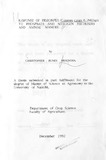| dc.description.abstract | Pigeonpea yields in East Africa are usually low ranging between 600-700
kg /ha. This has been attributed to a number of factors of which soil
factors such as nutrient levels is one of them. Comparatively little research
on the nutrition of pigeonpea appear to have been conducted.
An experiment was conducted for two seasons, at Kiboko and Machakos in
the first season, long rains 1989, and at Kiboko and Thika for the second
season, short rains 1989/90, to determine the response of two pigeonpea
cultivars, Katheka and NPP670 to fertilizer and manure application. Nitrogen
was applied at 15, 30 and 45 kg N/ha as urea (46% N). Phosphate was
applied as triple superphosphate (45%P20S) at the rates of 40, 80 and 120
kg/ha; while cow manure was applied at 5 and 10 tons/ha. Control plots
where no fertilizer or manure were added were also maintained. The
experimental design was a split-split block design with cultivars in the main plots,
fertilisers in the sub-plots and fertiliser levels in sub-sub plots.
At Thika in the short season 1989/90, the fertiliser and manure
applications did not have any significant effect on most of the parameters
measured. However urea application of 45 kg N/ha significantly increased the
pods dry matter and number of pods per plant.
At Kiboko in the long rains 1989, urea application of 15, 30 and 45 kg N/ha
increased grain yield by 5.4, 115.3, and 191 percent respectively, while in the
short rains 1989/'90, the same urea applications increased grain yield by 79.2,
52, and 84.6 percent respectively.Only urea application 30 and 45 kg N/ha
showed signillcant effect over the control. Manure application of 5 and 10 tons/ha
in the long rains 1989, increased grain yields by 35.1 and 62.8 percent,
respectively.Urea application of 30,45 kg N/ha and manure application of 10
tons/ha increased the stems and branches, pods dry matter and
the number of primary branches.
In the short rains 1989/'90, at Kiboko, phosphate application of -.f0,80 and
120 kg P20S/ha, increased grain yields by 102.7,80.3 and 11.6 percent
respectively. Sigruficant differences in, plant height, number of days to SO%
flowering and number of days to 50% maturity were observed between sites,
cultivars and seasons. Katheka was significantly taller than NPP 670 in the two
sites and took significantly longer period to reach 50% flowering and
subsequently longer period to reach 50% maturity. At Kiboko both NPP 670 and
katheka grown ill the shorr rains 1989/90 were significantly taller than those
grown ill the long rains 1989. Katheka plants grown at Kiboko in the short rains
1989/90 were tallest (366.5 em) followed by those grown at Thika in the short .
rains 1989/90 (304.2 em) with those grown at Klboko long rains were shortest
(211.5 em). NPP 670 plants grown at Kiboko in both seasons were significantly
taller than those grown at Thika (66.5 em). The one grown in short rains (12-+.9
em) were taller than those grown ill the long rains 1989 (l06 em). | en |

